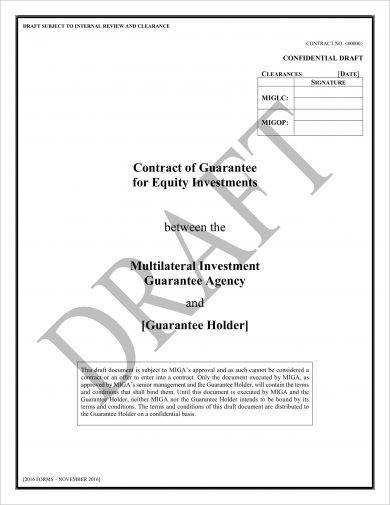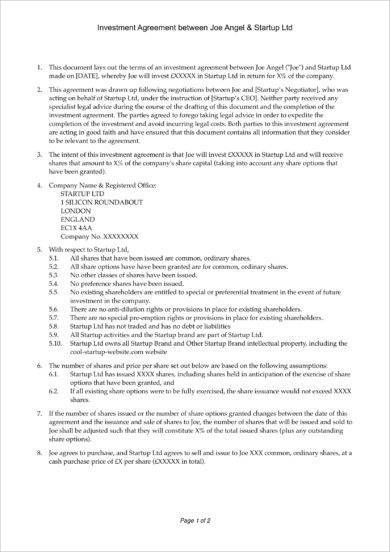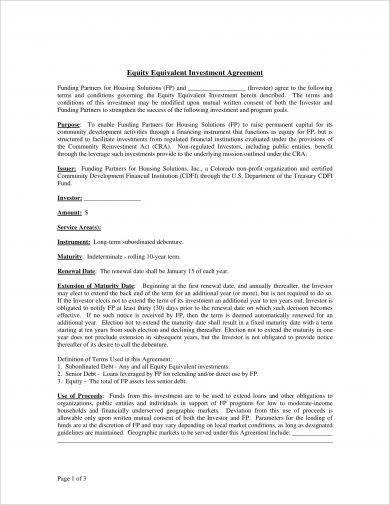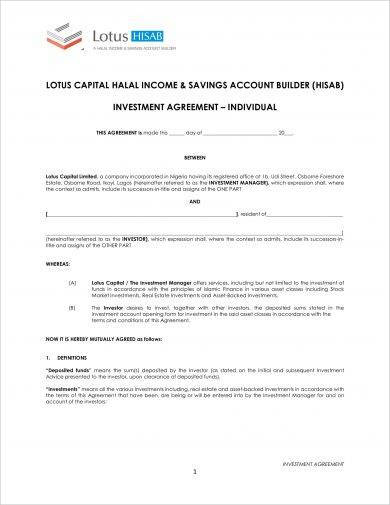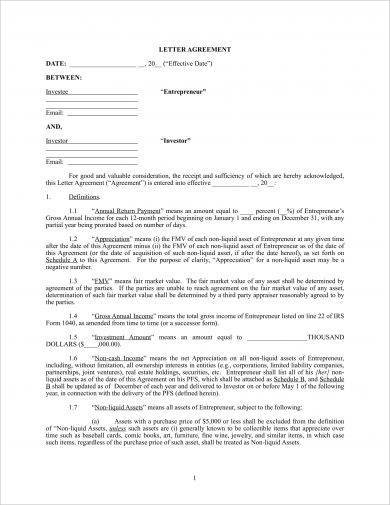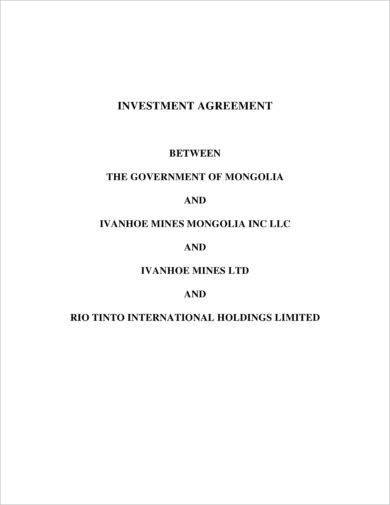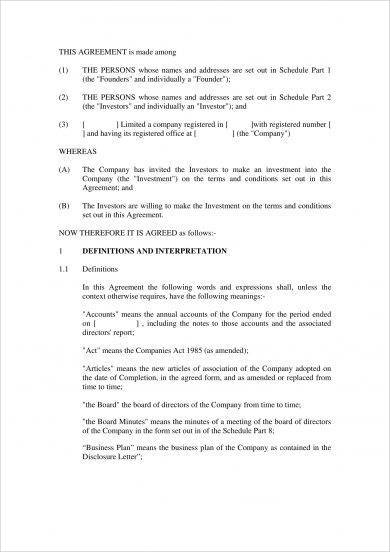8+ Equity Investment Agreement Examples
Equity, loans, and convertible debt—these are the most common types of investment funding that are usually undertaken by most business companies. They are just some of the many options including personal investment, fundraising, old-fashioned bootstrapping, and a lot more. You may also see investment proposals.
Before you seek funding from investors, make sure that you are certain in your idea that a support from the investor is the best way to move your business forward. When you and your team in your company have decide to go on an equity investment funding, it is best that you secure an equity investment agreement that binds the parties involved in the simple agreement. This would also secure both parties from any forms of fraud or deceit.
Examples of equity investment agreement are presented below.
Draft Equity Investment Agreement Example
Company Equity Investment Agreement Example
Comprehensive Equity Investment Agreement Example
Components of Equity
The equity component of a balance sheet and its recording and computation are something that are mostly feared by most accounting students, accountants, and even key personnel in an entity. The reason is the items in the equity is not tangible such as that of the physical asset. Only documents evidencing the ownership and the equity can be seen.
However, when you would like to go on an equity investment, it is vital that you must at least know the basics with regard to equity and its components.
When talking about equity investment, this obviously pertains to the investment that involves the equity components in a company’s balance sheet. So what are the components of equity? Below is a comprehensive discussion on the main components of equity. There might be other components, but the items listed below are always present in every company’s balance sheet. You may also see stock sale agreement
1. Capital Stock
This refers to the shares of the company sold to investors which represents ownership and provides benefits to the holder of such share including the right to receive dividends when the company pays them, the right to receive any remaining assets at liquidation, as well as voting rights. You may also like free partnership agreement
The share capital is recorded at par value or the dollar amount for each share which allows the company to record the issuance of capital stock in their financial statement. A note or disclosure must be provided in the financial statements stating the number of shares outstanding and the par value of each share.
2. Paid in Capital
The company sells the stock for a price agreed upon between the investor and the company, and the amount the company received when it issued the stock is called the paid in capital.
When it sells the stock, the company records the change in both the capital stock and the paid in capital, for paid in capital represents the difference of the money received between the par value and the selling price of the stock. This is also called share premium.You may also see subscription agreement examples
3. Treasury Stock
This represents shares of stock the company purchased of itself. These stocks have already been issued and the company purchased its own stock back in order to reduce the number of outstanding shares to manipulate the stock price or to award shares to employees. Treasury stock is reported as a deduction from stockholders’ equity for the total amount it pays.You may also see small business investment agreement
4. Retained Earnings
This represents the component of stockholders’ equity that are not from the stockholders. Retained earnings are generated from the income of the company. In the closing entries of a company, it must transfer its income summary to the retained earnings account. Net income increases the retained earnings and net loss decreases it. Retained earnings is decreased by the dividends paid when it pays to the stockholders.You may also see Subscription Agreement
Equity Subscription and Investment Agreement Example
Housing Group Equity Investment Agreement Example
Individual Equity Investment Agreement Example
Types of Investor Funding
There are several types of investor funding, and the most common ones are as follows: equity, loans, and convertible debt. Each funding will be discussed in detail below.
1. Equity
Equity funding means that the investors will receive a share in your company and its performance moving forward in exchange for the money that they invested today. Equity is said to be one of the most sought-after forms of capital for entrepreneurs because it is an attractive option and it is a form of capital that requires the most seeking. You may also like business investment agreement
- How it works? At the outset of your fundraiser, you need to set a specific valuation or an estimation of what your company is worth at that certain point. Based on that valuation as well as the amount of money the investor gives you, they will own a certain percentage of stock in your company. They will also receive proportional compensation for these stocks once your company sells or goes public. You may also check out sample letter of agreement examples.
- When to do it? There are several instances when only equity funding is the last resort for your company. These instances can be as follows:
- When you need a long runway
- When you have zero collateral
- When it is impossible for you to bootstrap
- When you are positioned for astronomical growth
- Things to keep in mind:
- Choosing an equity funding narrows your options when it comes to the future of your company as equity investors are only interested in one thing, which is the liquidity of the business, and this means that they will not be satisfied with a cut of your profits for each year; they are going to look for an assurance that your idea can not just sell but sell big. You might be interested in professional services agreement examples.
- Equity investors expect big rewards for big risks as it is one of the fundamental concepts of financial accounting: the greater the risk, the greater the reward.
- You also have to note that the competition for equity investments is high. That means that there are far more people looking for equity investors than there are checks being written.
- You have to be in the top percentile of the top percentile of the most prepared and motivated entrepreneurs so you can secure a check on your hand. You may also see dissolution agreement examples.
- Do not be in a hurry as raising equity capital would really take time. It would take three to six months to find the right investor for you.
- There is no room for giving up and there is no turning back.
2. Loans or Debt Financing
Financing through loans or debts is the easiest among these three. The basic concept is that you borrow money now and pay it back later with an interest according to the agreed interest rate. Debt is also the most common form of outside capital especially for new businesses who have just established their business and they need more funds for the business to survive. You may also like marketing agreement templates and examples.
- How it works? When you decide to go on debt or loan financing, you need to specify the terms of the interest rate that will come with the repayment of the loans that you receive and provide an expected time frame of when you will repay the loan. You may also include a collateral for your lenders to take from you in the event that you defaulted in your payment and that your business goes under which would ultimately result of you being unable to repay your loans. Collaterals would at least give a guarantee to your investor that you will pay your loans or else it will be taken from you. You may also check out service agreement examples.
- When to do it? These are the instances when you need to pursue loan-based financing:
- When you need less than $50,000
- When you really need to have capital immediately
- When you need the money for a very concrete and tangible reason such as when you need a computer or a real estate
- When equity funding option is not available
- Things to keep in mind.
- The more collateral you have, the greater the chance of securing a funding for collateral is the name of the game.
- When you carefully think about it, you can achieve the same goals with credit as you can with loans.
- It is important that you explore your debt options to see what is available and compare which one is better. You might be interested in partnership agreement examples.
3. Convertible Debt
Convertible debt is a combination of debt and equity because you borrow money from investors with the understanding that the loan will either be repaid or converted into a share in the company in a later period of time.
- How it works? You must specify on how will the debt be converted into equity at the time of the initial loan. This must be clearly stated to avoid misunderstanding and confusion between the two parties. Usually, the conversion involves some kind of incentive for investors to convert their debt into equity. This incentive can be in the form of a discount or warrant in the next fundraising. You must also set the interest rate in order to repay your investors unless they convert your loans into stocks. You may also see purchase agreement examples.
- When to do it? This is usually done by start-up companies who are not yet ready to set a valuation for their company because it is either too early to determine the valuation or they believe and expect that the valuation will be higher sometime in the future. In this case, if you believe your company’s valuation is likely to be higher at a later date, you can offer a convertible debt because this has the advantage of getting the funds you need now and enabling you to protect the value of your company in the future. You may also like conciliation agreement examples.
- Things to keep in mind.
- Convertible debt offerings can be extremely attractive for most investors as they have the option to claim your loan or convert them into stocks when they later fond out that the value of your equity is increasing. They get the chance to know and observe your operation and decide from that on how they deal with your debt. You may also check out non-compete agreement examples.
- Convertible debt are by nature a bit more open-ended than either debt or equity because the investors have the freedom to choose their own convertible path. As for you, you must provide clear reasons for that decision and a clear expectation with regard to the operations of your business. You may also see rental agreement letter examples.
- Businesses in the early start-up tend to like convertible debt fundraising because of its ability to move fast and the transaction costs are low.
- Lastly, other investors do not perceive convertible debt offerings as an advantage. They would like to know the percentage of a company that they will own right away, and they do not like taking small risks as this would mean small returns. In such a case, you can offer higher discounts for them. You might be interested in contractor agreement examples.
Personal Equity Investment Agreement Example
Private Equity Investment Agreement Example
Scottish Equity Investment Agreement Example
Overall
There are really instances when we need additional funding so our businesses can move forward. Equity investment funding is just one of the many types of funding that is used by many business entities to help their companies sustain and grow. The different types of investor funding are equity, loans, and convertible debt, which was explained in detail in the previous section. You may also like printable agreement examples.
When talking about equity investment, one must have at least the basic knowledge of the components of a company’s equity which are as follows: capital stock, paid in capital, treasury stock, and retained earnings.
It is best that you secure an equity investment agreement that will serve as a binding contract whenever you enter into an equity investment. Don’t forget to check out the examples of equity investment agreement presented above.



